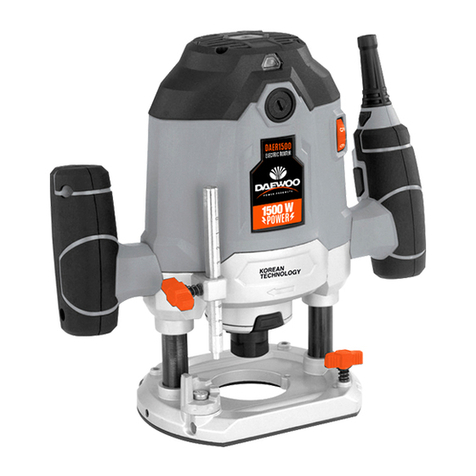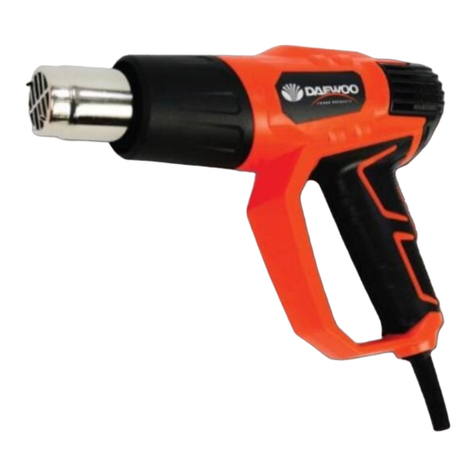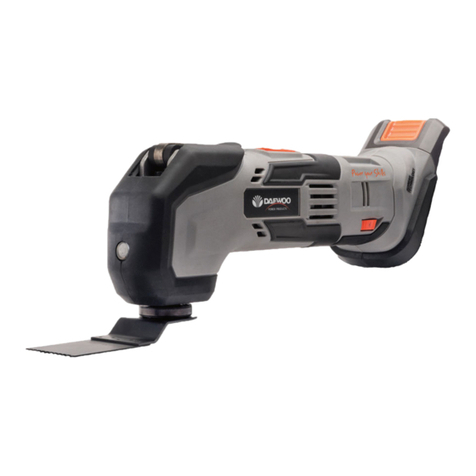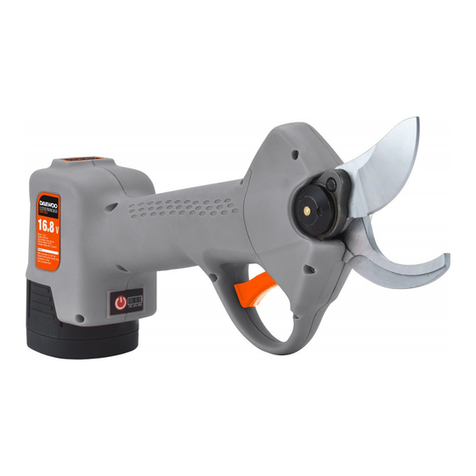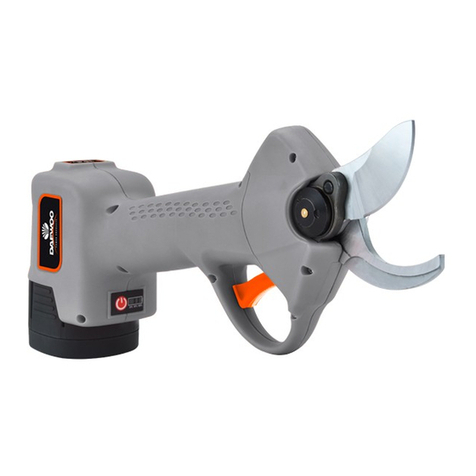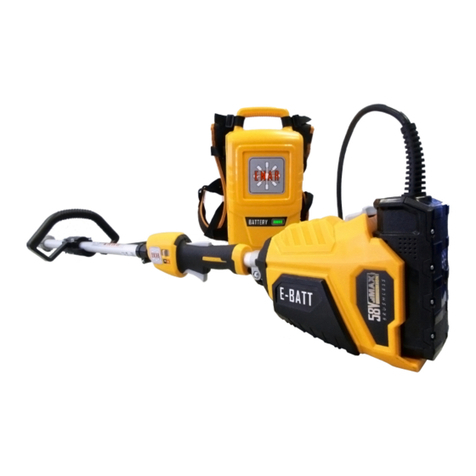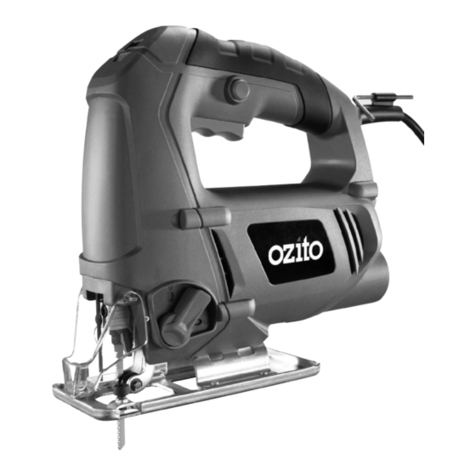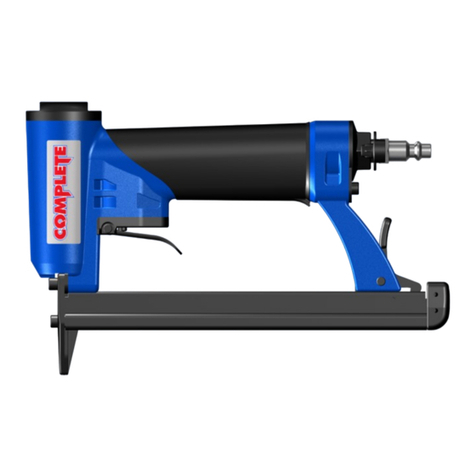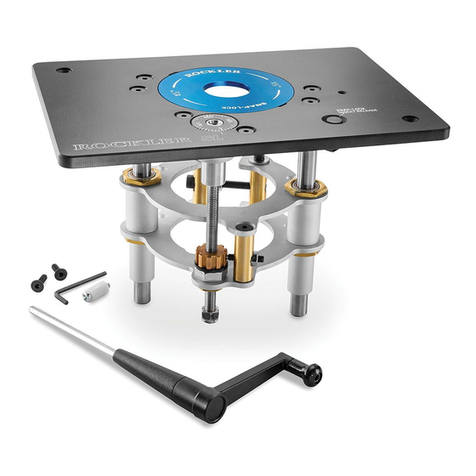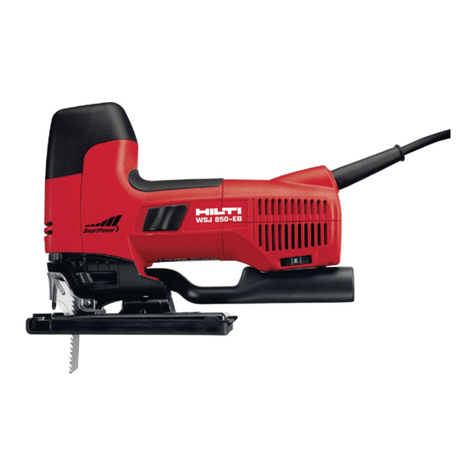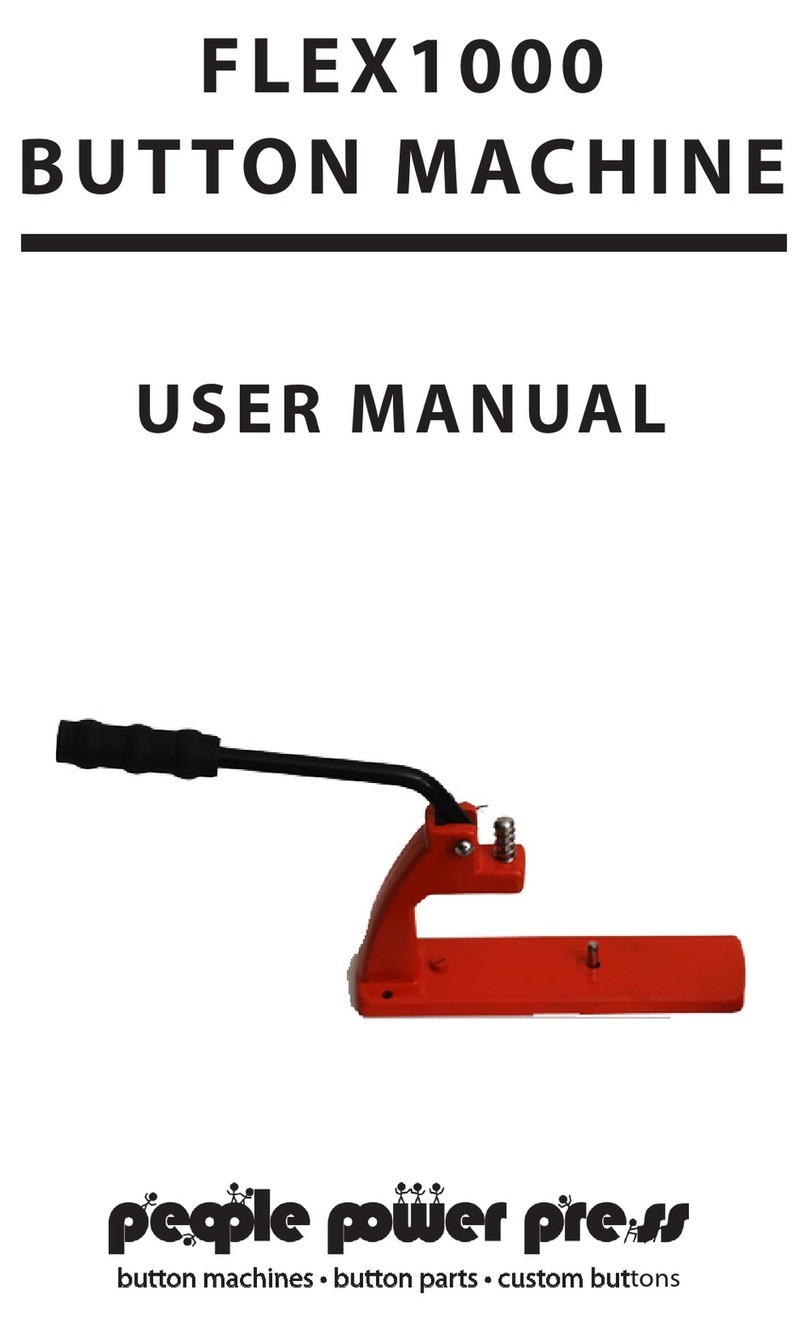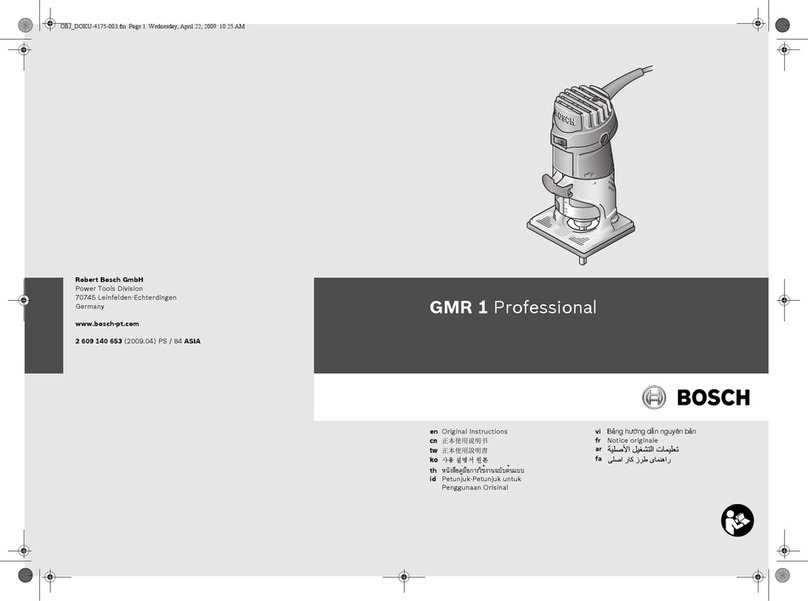Daewoo DALGS18-1 User manual

Manufactured under license of Daewoo International Corporation, Korea
www.daewoopowerproducts.com
USER'S MANUAL
DALGS18-1
LITHIUM GRASS SHEAR

2
INDEX
1
. GENERAL SAFETY INSTRUCTIONS FOR ELECTRIC TOOLS .......................................................5
2. SAFETY REGULATIONS .........................................................................................................................9
3. PROPER USE ..........................................................................................................................................11
4. BEFORE STARTING THE EQUIPMENT .................................................................................................11
5. OPERATION ............................................................................................................................................12
6. CLEANING, MAINTENANCE AND ORDERING OF SPARE PARTS .....................................................13
7. TECHNICAL DATA ..................................................................................................................................15
8. EXPLODED VIEW AND SPARE PARTS LIST
.......................................................................................16
WARRANTY ............................................................................................................................................... 17

EN
3
6b
1
2
3
4
5
34
2
8
7
6
6
9

4
5
7
3
4
C
8
6
B
A
3
C
4
6
8

EN
5
1. GENERAL SAFETY INSTRUCTIONS FOR ELECTRIC TOOLS
WARNING
Read all the safety information, instructions, illustrations and technical data provided on or with this
power tool. Failure to adhere to the following instructions may result in electric shock, fire and/or
serious injury. Keep all the safety information and instructions in a safe place for future use.
This equipment is not intended to be used by children, persons with reduced physical, sensory or
mental capacities or with a lack of experience and knowledge, or persons who are not familiar with
the instructions.
Children should be supervised so that they do not play with the equipment. Children are not allowed
to carry out cleaning or maintenance work.
Safety instructions for cordless grass and shrub shears
• Never allow persons who are not familiar with these operating instructions or children to use the
machine.
-Before use, you must examine the machine visually for damaged and for missing or wrongly fitted
safety devices or covers.
Eye protection, sturdy shoes and long trousers must be worn throughout the time spent using the
machine.
• Never use the machine with a damaged cover or safety device or when a cover or safety device is
missing.
• Switch on the equipment only when there are no hands or feet within range of the cutting unit.
• Take out the removable battery
1) whenever the machine is left unattended;
2) before you clear a blockage;
3) before you inspect, clean or work on the machine;
4) to check the machine for damage after it has struck a foreign body;
5) to carry out an immediate inspection whenever the machine starts to vibrate oddly.
• Take out the removable battery before maintenance or cleaning is performed.
• The machine must be inspected and serviced regularly. Have the machine repaired only in an
authorized workshop.
• Avoid abnormal working postures and always keep your balance so that you stand squarely on
inclines at all times. Walk, don‘t run.
• Warning! Do not touch moving hazardous parts before the removable battery has been taken out
and the moving hazardous parts have come to a complete standstill.
• Before you begin your work, examine the material you want to cut. Remove any foreign bodies.
Keep a continuous watch out for foreignbodies while you are working. If you come across any
foreign bodies while cutting, turn off the device (release the ON button) and remove the items in
question.
• Keep the device at a suitable distance from your body while working. Only switch on the device
when all parts of the body are well out of the way.
• Make sure that no people or animals ever come within the working or swiveling range of the
device.

6
• Only use the device in broad daylight or make sure that you provide adequate artificial light.
• Important! The cutting tools continue running on after the device has been switched off.
• When the device is not in use, make sure that it is stored in such a way that there is no risk of
hands coming into contact with the cutting blades.
• If the cutting blades get jammed while cutting, turn off the device (release the ON button) and
remove the object in question (thick branch, foreign body) with a suitable blunt aid. Never remove
any such objects with your fingers as the pre-tensioned blade can cause serious injuries through
cutting.
• Keep the air vents clean.
• Keep the charging cable away from the blades. Never use the device with the charging cable
plugged in.
• We recommend that you use a socket with a residual current device with maximum 30mA tripping
current for the charger.
• Never attempt to remove the cuttings with the motor running or to hold material you wish to cut.
Always switch off the device before attempting to remove any jammed cuttings.
• Make sure you keep all parts of your body away from the blade. Never attempt to remove the
cuttings with the blade running or to hold the material you wish to cut. Always switch off the equip-
ment before attempting to remove any jammed cuttings. A single moment of carelessness when
using the hedge trimmer can result in serious injuries.
• Carry the hedge trimmer by its handle with the blades at a standstill. Always fit the protective
cover when transporting the hedge trimmer or putting it into storage. Careful handling of the equip-
ment reduces the likelihood of injury by the blade.
• Hold the power tool by the insulated handles because the blade may strike concealed power
cables. Contact between the blade and a live cable can make the metal parts of the equipment live
and cause an electric shock.
• Hold the equipment correctly, for example with both hands if the equipment is fitted with two
handles.
• Make sure you stand squarely at all times while working. Be careful when walking backwards.
Tripping hazard!
• Never leave the equipment unsupervised in the work area. If you stop work for a while, leave the
equipment in a safe place.
• If you stop your work in order to go to another area to work, you must make sure that the equip-
ment is switched off while you are going there.
• Make sure you maintain a steady foothold on inclines at all times; walk – do not run.
• It is prohibited to work when there is a risk of bad weather or lightning.
• Ensure that somebody is in the vicinity (but at a safe distance) in case of an accident.
• Warning! The switching arrangements installed on the tool by the manufacturer must not be remo-
ved or bypassed, e.g. by fitting a switching button to the handle, as this may result in risk of injury
and the tool will no longer switch off automatically.
USING AND HANDLING THE CORDLESS TOOL
a) Only charge the batteries in chargers that are recommended by the manufacturer. A charger that
is designed for a certain type of battery may pose a fire risk if it is used with other types of battery.
b) Use only the correct batteries in the electric tools. The use of other batteries may result in injuries
and a fire risk.
c) Keep unused batteries away from paper clips, coins, keys, nails, screws and other metallic
objects that could cause a short circuit between the contacts. A short circuit between the battery
contacts may cause burns or a fire.

EN
7
d) In case of incorrect use, fluid may escape from the battery. Avoid contact with it. If you touch it by
accident, rinse the affected area with water. If you get the fluid in your eyes, also seek medical
advice. Leaking battery fluid can cause skin irritation or burns.
e) Never use damaged or altered rechargeable batteries. Damaged or altered rechargeable batteries
can behave unpredictably and lead to a risk of fire, explosion or injury.
f) Never expose a rechargeable battery to fire or high temperatures. Fire or temperatures over 130°C
pose a risk of explosion.
g) Follow all the instructions on charging and never charge the rechargeable battery or cordless tool
outside the specified allowable charging temperature range. Incorrect charging or charging outside
the allowable charging temperature range could cause irreparable damage to the battery and
increase the risk of fire.
Additional safety instructions
We pay a great deal of attention to the design of every battery pack to ensure that we supply you
with batteries which feature maximum power density, durability and safety. The battery cells have a
wide range of safety devices. Each individual cell is initially formatted and its electrical characteris-
tic curves are recorded. These data are then used exclusively to be able to assemble the best
possible battery packs. Despite all the safety precautions, caution must always be exercised when
handling batteries. The following points must be obeyed at all times to ensure safe use.
Safe use can only be guaranteed if undamaged cells are used. Incorrect handling can cause cell
damage.
Important: Analyses confirm that incorrect use and poor care are the main causes of the damage
caused by high performance batteries.
Information about the battery
1. The battery pack supplied with your cordless tool is not charged. The battery pack has to be
charged before you use the tool for the first time.
2. For optimum battery performance avoid low discharge cycles. Charge the battery pack frequent-
ly.
3. Store the battery pack in a cool place, ideally at 15°C and charged to at least 40%.
4. Lithium-ion batteries are subject to a natural ageing process. The battery pack must be replaced
at the latest when its capacity falls to just 80% of its capacity when new. Weakened cells in an aged
battery pack are no longer capable of meeting the high power requirements and therefore pose a
safety risk.
5. Do not throw battery packs into an open fire. There is a risk of explosion!
6. Do not ignite the battery pack or expose it to fire.
7. Do not exhaustively discharge batteries. Exhaustive discharge will damage the battery cells. The
most common cause of exhaustive discharge is lengthy storage or non-use of partly discharged
batteries. Stop working as soon as the performance of the battery falls noticeably or the electronic
protection system triggers. Place the battery pack in storage only after it has been fully charged.
8. Protect batteries and the tool from overloads. Overloads will quickly result in overheating and cell
damage inside the battery housing without this overheating actually being apparent externally.
9. Avoid damage and shocks. Replace batteries which have been dropped from a height of more
than one meter or which have been exposed to violent shocks without delay, even if the housing of
the battery pack appears to be undamaged. The battery cells inside the battery may have suffered
serious damage. In this respect, please also read the waste disposal information.
10. If the battery pack suffers overloading and overheating, the integrated protective cut off will

8
switch off the equipment for safety reasons. Important. Do not press the ON/OFF switch any more if
the protective cut-off has actuated. This may damage the battery pack.
11. Use only original battery packs. The use of other batteries may result in injuries, explosion and a
fire risk.
12. Protect your rechargeable battery against moisture, rain and high humidity.
Moisture, rain and high humidity can cause dangerous cell damage. Never charge or work with
batteries which have been exposed to moisture, rain or high humidity – replace them immediately.
13. If your equipment is fitted with a detachable battery, remove the battery for safety reasons after
you have finished your work
Information on chargers and the charging process
1. Please check the data marked on the rating plate of the battery charger. Be sure to connect the
battery charger to a power supply with the voltage marked on the rating plate. Never connect it to a
different mains voltage.
2. Protect the battery charger and its cable from damage and sharp edges. Have damaged cables
repaired without delay by a qualified electrician.
3. Keep the battery charger, batteries and the cordless tool out of children’s reach.
4. Do not use damaged battery chargers.
5. Do not use the supplied battery charger to charge other cordless tools.
6. In heavy use the battery pack will become warm. Allow the battery pack to cool to room tempera-
ture before commencing with the charging.
7. Do not over-charge batteries. Do not exceed the maximum charging times. These charging times
only apply to discharged batteries. Frequent insertion of a charged or partly charged battery pack
will result in over-charging and cell damage. Do not leave batteries in the charger for days on end.
8. Never use or charge batteries if you suspect that the last time they were charged was more than
12 months previously. There is a high probability that the battery pack has already suffered dange-
rous damage (exhaustive discharge).
9. Charging batteries at a temperature below 10°C will cause chemical damage to the cell and may
cause a fire.
10. Do not use batteries which have heated during the charging process, as the battery cells may
have suffered dangerous damage.
11. Do not use batteries which have suffered curvature or deformation during the charging process
or which show other non-typical symptoms (gassing, hissing, cracking,…)
12. Never fully discharge the battery pack (recommended depth of discharge max. 80%) A complete
discharge of the battery pack will lead to premature ageing of the battery cells.
13. Never charge the batteries unsupervised.
Protection from environmental influences
1. Wear suitable work clothes. Wear safety goggles.
2. Protect your cordless tool and the battery charger from moisture and rain. Moisture and rain can
cause dangerous cell damage.
3. Do not use the cordless tool or the battery charger near vapors and
inflammable liquids.
4. Use the battery charger and cordless tools only in dry conditions and an ambient temperature of
10-40°C.
5. Do not keep the battery charger in places where the temperature is liable to reach over 40°C. In
particular, do not leave the battery charger in a car that is parked in the sunshine.

EN
9
6. Protect batteries from overheating. Overloads, over-charging and exposure to direct sunlight will
result in overheating and cell damage. Never charge or work with batteries which have been over-
heated – replace them immediately if possible.
7. Storage of batteries, battery chargers and cordless tools. Store the charger and your cordless
tool only in dry places with an ambient temperature of 10-40°C. Store your lithium-ion battery pack
in a cool, dry place at a temperature of 10-20°C. Protect them from humidity and direct sunlight.
Only place fully charged batteries in storage (charged at least 40%).
8. Prevent the lithium-ion battery pack from freezing. Battery packs which were stored below 0°C for
more than 60 minutes must be disposed of.
9. When handling batteries beware of electrostatic charge: Electrostatic discharges cause damage
of the electronic protection system and the battery cells. Avoid electrostatic charging and never
touch the battery poles.
Batteries and cordless electric equipment contain materials that are potentially harmful to the
environment. Never place any rechargeable batteries or cordless electric machines or tools in your
household refuse.
The rechargeable battery should be taken to a suitable collection center for proper disposal. If you
do not know the whereabouts of such a collection center, you should ask in your local council
offices.
To ensure that any defective/damaged lithium-ion batteries are properly packaged and delivered
when you send them to us, please contact our customer service or the point of sale at which the
equipment was purchased.
When shipping or disposing of batteries and cordless tools, always ensure that they are packed
individually in plastic bags to prevent short circuits and fires.
Do not lose these safety instructions.
Danger!
When using the equipment, a few safety precautions must be observed to avoid injuries and
damage. Please read the complete operating instructions and safety regulations with due care.
Keep this manual in a safe place, so that the information is available at all times. If you give the
equipment to any other person, hand over these operating instructions and safety regulations as
well. We cannot accept any liability for damage or accidents which arise due to a failure to follow
these instructions and the safety instructions.
2. SAFETY REGULATIONS
The corresponding safety information can be found in the enclosed booklet.
Danger!
Read all safety regulations and instructions.
Any errors made in following the safety regulations and instructions may result in an electric shock,
fire and/or serious injury.
Keep all safety regulations and instructions in a safe place for future use.

10
This equipment is not intended to be used by children, persons with reduced physical, sensory or
mental capacities or with a lack of experience and knowledge, or persons who are not familiar with
the instructions.
Children should be supervised so that they do not play with the equipment. Children are not allowed
to carry out the cleaning or maintenance.
Explanation of the symbols (see Fig. 8)
1. Danger! Read the operating instructions and follow the warnings and safety instructions.
2. Keep all other persons away from the danger zone.
3. Danger! The cutter blades continue to run after the motor is switched off . Wait for the blades to
come to a standstill. Risk of injury!
4. Store the battery only in dry rooms with an ambient temperature of +10°C to +40°C. Place only
fully charged batteries in storage (charged at least 40-60%).
5. Protect the equipment from rain and moisture!
6. Guaranteed sound power level
7. Safety class II
8. For use in dry rooms only
2. Layout and items supplied
2.1 Layout (Fig. 1/2)
1. Grass cutter blade
2. Blade release mechanism
3. Safety lock-off
4. On / Off switch
5. Hedge cutter blade
6. Blade guard
7. Battery mount
8. Battery
9. Battery charger
2.2 Items supplied
Please check that the article is complete as specified in the scope of delivery. If parts are missing,
please contact our service center or the sales outlet where you made your purchase at the latest
within 5 working days after purchasing the product and upon presentation of a valid bill of purchase.
Also, refer to the warranty table in the service information at the end of the operating instructions.
• Open the packaging and take out the equipment with care.
• Remove the packaging material and any packaging and/or transportation braces (if available).
• Check to see if all items are supplied.
• Inspect the equipment and accessories for transport damage.
• If possible, please keep the packaging until the end of the guarantee period.
Danger!
The equipment and packaging material are not toys. Do not let children play with plastic bags, foils
or small parts. There is a danger of swallowing or suffocating!

EN
EN
11
• Cordless grass and shrub shears
• Original operating instructions
• Safety instructions
3. PROPER USE
Grass shears:
The equipment is designed for cutting the edges of lawns and small areas of grass in private and
hobby gardens.
Shrub shears:
The equipment is designed for cutting small hedges and shrubs in private and hobby gardens.
Equipment designed for use in private and hobby gardens is regarded as unsuitable for use in
public facilities, parks and sports centers, along roadways, or in agriculture and forestry. The opera-
ting instructions as supplied by the manufacturer must be obeyed to ensure that the equipment is
used properly.
Warning! This equipment must not be used for composting purposes
(shredding) as this could result in injury or damage to property.
The machine is to be used only for its prescribed purpose. Any other use is deemed to be a case of
misuse. The user / operator and not the manufacturer will be liable for any damage or injuries of any
kind caused as a result of this.
Please note that our equipment has not been designed for use in commercial, trade or industrial
applications. Our warranty will be voided if the machine is used in commercial, trade or industrial
businesses or for equivalent purposes
4. BEFORE STARTING THE EQUIPMENT
The equipment is supplied with battery and with a charger.
5.1 Charging the battery (Figure 3)
1. Take the battery pack out of the equipment. Press the push lock button (Fig. 4/ Item C).
2. Check that your mains voltage is the same as that marked on the rating plate of the battery char-
ger. Insert the power plug of the charger into the socket outlet. The green LED will light on.
3. Insert the battery pack onto the battery charger.
4. The red LED will light up until the battery is fully charged. The red LED turns green.
The battery pack can become a little warm during the charging. This is normal.
If the battery pack fails to charge, check:
• whether there is voltage at the socket outlet
• whether there is good contact at the charging contacts
If the battery pack still fails to charge, send
• the charging unit
• and the battery pack to our customer service center.

12
To ensure that items are properly packaged and delivered when you send them to us, please con-
tact our customer service or the point of sale at which the equipment was purchased.
When shipping or disposing of batteries and cordless tools, always ensure that they are packed
individually in plastic bags to prevent short circuits and fires.
To ensure that the battery pack provides long service, you should take care to recharge it promptly.
You must recharge the battery pack when you notice that the performance of the device drops.
Never allow the battery pack to become fully discharged. This will cause it to develop a defect.
5.2 Battery capacity indicator (Fig. 4)
Press the button for the battery capacity indicator (Item B). The battery capacity indicator (Item A)
shows the charge status of the battery using 3 LEDs
All 3 LEDs are lit:
The battery is fully charged.
2 or 1 LED(s) are lit:
The battery has an adequate remaining charge.
1 LED blinks:
The battery is empty, recharge the battery.
Warning! Any foreign bodies must be completely cleared away from the area to be worked on.
Warning!
The switching devices installed on the tool by the manufacturer are not allowed to be removed or
bypassed, e.g. by fitting a switching button to the handle, as this may result in risk of injury and the
tool will no longer switch off automatically.
5. OPERATION
6.1 Using the equipment as grass shears
Allow the grass shears to glide over the ground. The best cutting performance is achieved on dry
lawns. The blade guard hood must be slid over the blade and the rechargeable battery removed
when the equipment is not being used. The grass shears is supplied ready assembled.
1. (Fig. 5) Push the battery into the battery mount provided (Fig. 2/Item 7)
until you hear the catch click into position. To take out the battery, press the push lock button (Item
C) and remove the battery.
2. (Fig. 5) Remove the blade guard hood (Item 6).
3. (Fig. 5) To switch on, push the safety lock-off forward (Item 3) and press the On/Off switch (Item
4) at the same time.
4. To switch off , let go of the On/Off switch.
6.2 Using the equipment as shrub shears
Hold the shrub shears slightly tilted in the direction of the shrub you wish to cut. Start by cutting the
sides of the shrub working from the bottom up, and finally cut the top of the shrub. The blade guard

d) In case of incorrect use, fluid may escape from the battery. Avoid contact with it. If you touch it by
accident, rinse the affected area with water. If you get the fluid in your eyes, also seek medical
advice. Leaking battery fluid can cause skin irritation or burns.
e) Never use damaged or altered rechargeable batteries. Damaged or altered rechargeable batteries
can behave unpredictably and lead to a risk of fire, explosion or injury.
f) Never expose a rechargeable battery to fire or high temperatures. Fire or temperatures over 130°C
pose a risk of explosion.
g) Follow all the instructions on charging and never charge the rechargeable battery or cordless tool
outside the specified allowable charging temperature range. Incorrect charging or charging outside
the allowable charging temperature range could cause irreparable damage to the battery and
increase the risk of fire.
Additional safety instructions
We pay a great deal of attention to the design of every battery pack to ensure that we supply you
with batteries which feature maximum power density, durability and safety. The battery cells have a
wide range of safety devices. Each individual cell is initially formatted and its electrical characteris-
tic curves are recorded. These data are then used exclusively to be able to assemble the best
possible battery packs. Despite all the safety precautions, caution must always be exercised when
handling batteries. The following points must be obeyed at all times to ensure safe use.
Safe use can only be guaranteed if undamaged cells are used. Incorrect handling can cause cell
damage.
Important: Analyses confirm that incorrect use and poor care are the main causes of the damage
caused by high performance batteries.
Information about the battery
1. The battery pack supplied with your cordless tool is not charged. The battery pack has to be
charged before you use the tool for the first time.
2. For optimum battery performance avoid low discharge cycles. Charge the battery pack frequent-
ly.
3. Store the battery pack in a cool place, ideally at 15°C and charged to at least 40%.
4. Lithium-ion batteries are subject to a natural ageing process. The battery pack must be replaced
at the latest when its capacity falls to just 80% of its capacity when new. Weakened cells in an aged
battery pack are no longer capable of meeting the high power requirements and therefore pose a
safety risk.
5. Do not throw battery packs into an open fire. There is a risk of explosion!
6. Do not ignite the battery pack or expose it to fire.
7. Do not exhaustively discharge batteries. Exhaustive discharge will damage the battery cells. The
most common cause of exhaustive discharge is lengthy storage or non-use of partly discharged
batteries. Stop working as soon as the performance of the battery falls noticeably or the electronic
protection system triggers. Place the battery pack in storage only after it has been fully charged.
8. Protect batteries and the tool from overloads. Overloads will quickly result in overheating and cell
damage inside the battery housing without this overheating actually being apparent externally.
9. Avoid damage and shocks. Replace batteries which have been dropped from a height of more
than one meter or which have been exposed to violent shocks without delay, even if the housing of
the battery pack appears to be undamaged. The battery cells inside the battery may have suffered
serious damage. In this respect, please also read the waste disposal information.
10. If the battery pack suffers overloading and overheating, the integrated protective cut off will
EN
13
hood must be slid over the blade and the rechargeable battery removed when the equipment is not
being used.
• Shrubs which loose their leaves in the autumn should be cut in June and October.
• Evergreen shrubs should be cut in April and August.
6.2.1 Assembly
Since the equipment is supplied as grass shears (see section 6.1), the grass cutting blade has to be
swapped over for the shrub cutter blade which is supplied with the product. Caution! Carry out all
the following assembly, dismantling and adjustment work without a rechargeable battery – risk of
injury. Use protective gloves and the blade guard hood which is supplied with the equipment.
1. Push the blade release buttons (Fig. 6a) on both sides and remove the blade at the same(Fig. 6b).
2. Slide the blade housing into the mount on the equipment housing.
3. Push the blade release buttons on both sides again(Fig.7) and press the blade into the mount at
the same time. The drive unit on the equipment is now connected to the blade.
4. Push the battery into the battery mount provided until you hear the catch click into position.
6.2.2 Switching on/off .
Proceed as described in section 6.1.
6. CLEANING, MAINTENANCE AND ORDERING OF SPARE PARTS
Danger! Remove the rechargeable battery!
7.1 Cleaning
• Keep all safety devices, air vents and the motor housing free of dirt and dust as far as possible.
Wipe the equipment with a clean cloth or blow it with compressed air at low pressure.
• We recommend that you clean the device immediately each time you have finished using it.
• Clean the equipment regularly with a moist cloth. Do not use cleaning agents or solvents; these
could attack the plastic parts of the equipment. Ensure that no water can seep into the device. The
ingress of water into an electric tool increases the risk of an electric shock.
• The shears should be cleaned thoroughly every time before and after use. A few drops of oil (for
example sewing machine oil) applied to the blades improve the cutting performance. However, never
apply grease to the blades.
• To guarantee a constant exact cut it is necessary that grass residues and dirt are also removed
from the top and bottom blades.
Caution!
Because of the risk of injury or damage to property, never clean the product with running water,
especially not with a pressure hose. Store the cordless shears in a dry and frost-free location. The
storage place must be inaccessible to children.
7.2 Maintenance
• For good cutting performance the blades should always be sharp. They can be therefore be resha-
rpened with a whetstone. In particular we recommend to remove notches and ridges which are
produced on the blades by stones or the like.
• There are no other parts inside the equipment which require maintenance.
7.3 Ordering replacement parts:
Please quote the following data when ordering replacement parts:
• Type of machine
• Article number of the machine

14
switch off the equipment for safety reasons. Important. Do not press the ON/OFF switch any more if
the protective cut-off has actuated. This may damage the battery pack.
11. Use only original battery packs. The use of other batteries may result in injuries, explosion and a
fire risk.
12. Protect your rechargeable battery against moisture, rain and high humidity.
Moisture, rain and high humidity can cause dangerous cell damage. Never charge or work with
batteries which have been exposed to moisture, rain or high humidity – replace them immediately.
13. If your equipment is fitted with a detachable battery, remove the battery for safety reasons after
you have finished your work
Information on chargers and the charging process
1. Please check the data marked on the rating plate of the battery charger. Be sure to connect the
battery charger to a power supply with the voltage marked on the rating plate. Never connect it to a
different mains voltage.
2. Protect the battery charger and its cable from damage and sharp edges. Have damaged cables
repaired without delay by a qualified electrician.
3. Keep the battery charger, batteries and the cordless tool out of children’s reach.
4. Do not use damaged battery chargers.
5. Do not use the supplied battery charger to charge other cordless tools.
6. In heavy use the battery pack will become warm. Allow the battery pack to cool to room tempera-
ture before commencing with the charging.
7. Do not over-charge batteries. Do not exceed the maximum charging times. These charging times
only apply to discharged batteries. Frequent insertion of a charged or partly charged battery pack
will result in over-charging and cell damage. Do not leave batteries in the charger for days on end.
8. Never use or charge batteries if you suspect that the last time they were charged was more than
12 months previously. There is a high probability that the battery pack has already suffered dange-
rous damage (exhaustive discharge).
9. Charging batteries at a temperature below 10°C will cause chemical damage to the cell and may
cause a fire.
10. Do not use batteries which have heated during the charging process, as the battery cells may
have suffered dangerous damage.
11. Do not use batteries which have suffered curvature or deformation during the charging process
or which show other non-typical symptoms (gassing, hissing, cracking,…)
12. Never fully discharge the battery pack (recommended depth of discharge max. 80%) A complete
discharge of the battery pack will lead to premature ageing of the battery cells.
13. Never charge the batteries unsupervised.
Protection from environmental influences
1. Wear suitable work clothes. Wear safety goggles.
2. Protect your cordless tool and the battery charger from moisture and rain. Moisture and rain can
cause dangerous cell damage.
3. Do not use the cordless tool or the battery charger near vapors and
inflammable liquids.
4. Use the battery charger and cordless tools only in dry conditions and an ambient temperature of
10-40°C.
5. Do not keep the battery charger in places where the temperature is liable to reach over 40°C. In
particular, do not leave the battery charger in a car that is parked in the sunshine.
• Identification number of the machine
• Replacement part number of the part required
8. Disposal and recycling
The unit is supplied in packaging to prevent its being damaged in transit. This packaging is raw
material and can therefore be reused or can be returned to the raw material system. The unit and its
accessories are made of various types of material, such as metal and plastic. Defective components
must be disposed of as special waste.
9. Storage and transport
Remove the rechargeable battery. Store the equipment and its accessories in a dark and dry place
at above freezing temperature. The ideal storage temperature is between 5 and 30 °C. Store the
electric tool in its original packaging.
• Always hold the equipment on the handle.
• Secure the equipment against slipping if you transport it in a vehicle.
• As far as possible, use the original packaging for transporting the equipment.
• Use a transport guard for the grass and shrub shears.
10. Faults
The equipment does not work
• Check that the battery is charged (push button „B“ on the battery) and whether the charging unit
is working.
• Check that the rechargeable battery is pushed fully into the battery mount and is locked in posi-
tion. If the equipment will not work in spite of the voltage supply being OK, please send it to the
customer service address below.
For EU countries only
Never place any electric power tools in your household refuse.
To comply with European Directive 2012/19/EU concerning old electric and electronic equipment
and its implementation in national laws, old electric power tools have to be separated from other
waste and disposed of in an environment-friendly fashion, e.g. by taking to a recycling depot.
Recycling alternative to the return request:
As an alternative to returning the equipment to the manufacturer, the owner of the electrical equip-
ment must make sure that the equipment is properly disposed of if he no longer wants to keep the
equipment. The old equipment can be returned to a suitable collection point that will dispose of the
equipment in accordance with the national recycling and waste disposal regulations. This does not
apply to any accessories or aids without electrical components supplied with the old equipment.
This consignment contains lithium-ion batteries.
In accordance with special provision 188 this consignment is not subject to the ADR regulations.
Handle with care. Danger of ignition in case of damage to the consignment package. If the consign-
ment package is damaged: Check and if necessary repackage. Subject to technical changes.

7. TECHNICAL DATA
Power: 20 V
Running time: up to 40 min (base on 1.5Ah)
No-load speed: 1200 rpm
Blade material: SK5
Hedge trimmer cutting width: 200 mm
Teeth distance: 8 mm
Grass shear blade cutting width: 100 mm
Thickness of grass blade: 1.3 mm/1.5 mm (upper/lower)
Thickness of grass blade: 1.5 mm
Quick blade change system
Battery and charger not included
• The vibration emission level has been measured in accordance with a set of standardized criteria
and can be used to compare one power tool with another;
• The specified emission level can also be used to make an initial assessment of the exposure to
vibration.
Warning!
The vibration value changes according to the area of application of the electric equipment and may
exceed the specified value in exceptional circumstances.
Keep the noise emissions and vibrations to a minimum.
• Only use appliances which are in perfect working order.
• Service and clean the appliance regularly.
• Adapt your working style to suit the appliance.
• Do not overload the appliance.
• Have the appliance serviced whenever necessary.
• Switch the appliance off when it is not in use.
• Wear protective gloves.
Limit the operating time!
All stages of the operating cycle must be considered (for example, times in which the electric tools
are switched off and times in which the tool is switched on but operates without load).
Caution!
Residual risks
Even if you use this electric power tool in accordance with instructions, certain residual risks cannot
be rules out. The following hazards may arise in connection with the equipment’s construction and
layout:
1. Lung damage if no suitable protective dust mask is used.
2. Damage to hearing if no suitable ear protection is used.
3. Health damage caused by hand-arm vibrations if the equipment is used over a prolonged period
or is not properly guided and maintained.
Danger!
EN
15

This equipment is not intended to be used by children, persons with reduced physical, sensory or
mental capacities or with a lack of experience and knowledge, or persons who are not familiar with
the instructions.
Children should be supervised so that they do not play with the equipment. Children are not allowed
to carry out the cleaning or maintenance.
Explanation of the symbols (see Fig. 8)
1. Danger! Read the operating instructions and follow the warnings and safety instructions.
2. Keep all other persons away from the danger zone.
3. Danger! The cutter blades continue to run after the motor is switched off . Wait for the blades to
come to a standstill. Risk of injury!
4. Store the battery only in dry rooms with an ambient temperature of +10°C to +40°C. Place only
fully charged batteries in storage (charged at least 40-60%).
5. Protect the equipment from rain and moisture!
6. Guaranteed sound power level
7. Safety class II
8. For use in dry rooms only
2. Layout and items supplied
2.1 Layout (Fig. 1/2)
1. Grass cutter blade
2. Blade release mechanism
3. Safety lock-off
4. On / Off switch
5. Hedge cutter blade
6. Blade guard
7. Battery mount
8. Battery
9. Battery charger
2.2 Items supplied
Please check that the article is complete as specified in the scope of delivery. If parts are missing,
please contact our service center or the sales outlet where you made your purchase at the latest
within 5 working days after purchasing the product and upon presentation of a valid bill of purchase.
Also, refer to the warranty table in the service information at the end of the operating instructions.
• Open the packaging and take out the equipment with care.
• Remove the packaging material and any packaging and/or transportation braces (if available).
• Check to see if all items are supplied.
• Inspect the equipment and accessories for transport damage.
• If possible, please keep the packaging until the end of the guarantee period.
Danger!
The equipment and packaging material are not toys. Do not let children play with plastic bags, foils
or small parts. There is a danger of swallowing or suffocating!
16
8. EXPLODED VIEW AND SPARE PARTS LIST

• Cordless grass and shrub shears
• Original operating instructions
• Safety instructions
3. PROPER USE
Grass shears:
The equipment is designed for cutting the edges of lawns and small areas of grass in private and
hobby gardens.
Shrub shears:
The equipment is designed for cutting small hedges and shrubs in private and hobby gardens.
Equipment designed for use in private and hobby gardens is regarded as unsuitable for use in
public facilities, parks and sports centers, along roadways, or in agriculture and forestry. The opera-
ting instructions as supplied by the manufacturer must be obeyed to ensure that the equipment is
used properly.
Warning! This equipment must not be used for composting purposes
(shredding) as this could result in injury or damage to property.
The machine is to be used only for its prescribed purpose. Any other use is deemed to be a case of
misuse. The user / operator and not the manufacturer will be liable for any damage or injuries of any
kind caused as a result of this.
Please note that our equipment has not been designed for use in commercial, trade or industrial
applications. Our warranty will be voided if the machine is used in commercial, trade or industrial
businesses or for equivalent purposes
4. BEFORE STARTING THE EQUIPMENT
The equipment is supplied with battery and with a charger.
5.1 Charging the battery (Figure 3)
1. Take the battery pack out of the equipment. Press the push lock button (Fig. 4/ Item C).
2. Check that your mains voltage is the same as that marked on the rating plate of the battery char-
ger. Insert the power plug of the charger into the socket outlet. The green LED will light on.
3. Insert the battery pack onto the battery charger.
4. The red LED will light up until the battery is fully charged. The red LED turns green.
The battery pack can become a little warm during the charging. This is normal.
If the battery pack fails to charge, check:
• whether there is voltage at the socket outlet
• whether there is good contact at the charging contacts
If the battery pack still fails to charge, send
• the charging unit
• and the battery pack to our customer service center.
EN
17
shrub shear blade assy I 1
nut M4 4
E washer 4Φ16*Φ4.3*Φ1.5 4
range ring 4
upper shrub shear blade 1
limit ring for shrub shear blade 1
lower shrub shear blade 1
screw M4*10 4
shrub shear blade cover 1
right button of the blade cover 1
blade box bottom 1
left button of the blade cover 1
eccentric gear 1
blade box cap 1
self-tapping screw ST2.9*13 4
dust sponge with gum 1
grass shear blade assy II 1
right button of the blade cover 1
blade box bottom 1
left button of the blade cover 1
eccentric gear 1
blade box cap 1
self-tapping screw ST2.9*13 4
dust sponge with gum 1
upper grass shear blade 1
limit ring for grass shear blade 1
connector 1
lower grass shear blade 1
grass blade cover 1
main body Assy 1
self-tapping screw ST2.9*13 6
motor 1
gear box plate 1
screw M2.5*7 2
small gear 1
washer 5 12ΦXΦ5.2X1 1
linkage gear 1
bigger gear 1
spring for switch trigger 1
switch push button 1
components assembly 1
spring for switch trigger 1
switch button 1
self-tapping screw ST2.9*12 2
left housing base 1
left housing of socket 1
right housing of socket 1
right housing base 1
battery pack 2.0Ah 1
charger 1
1
2
3
4
5
6
7
8
9
10
11
12
13
14
15
9
10
11
12
13
14
15
16
17
18
19
20
33
34
35
36
14
21
22
23
24
26
27
28
29
30
31
32
25
37
39
38

GUARANTEE
WARRANTY DOES NOT COVER
Product model
Serial number
Username
Date of sale
Company
Client's signature
The warranty period starts from the date of sale of the products and covers 2 years for all power products.
During the warranty period, free failures caused due to the use of poor-quality materials in the production and
manufacturer workmanship admitted fault are removed. The guarantee comes into force only when warranty card
and cutting coupons are properly filled. The product is accepted for repair in its pure form and full completeness.
• Mechanical damage (cracks, chips, etc.) and damage
caused by exposure to aggressive media, foreign objects
inside the unit and air vents, as well as for damage
occurred as a result of improper storage (corrosion of metal
parts);
• Failures caused by overloading or product misuse, use of
the product for other purposes. A sure sign of overload
products is melting or discoloration of parts due to the high
temperature, simultaneous failure of two or more nodes,
teaser on the surfaces of the cylinder and the piston or
destruction of piston rings. Also, the warranty does not
cover failure of the automatic voltage regulator due to
incorrect operation;
• Failure caused by clogging of the fuel and cooling systems;
• Wearing parts (carbon brushes, belts, rubber seals, oil
seals, shock absorbers, springs, clutches, spark plugs,
mufflers, nozzles, pulleys, guide rollers, cables, recoil starter,
chucks, collets, removable batteries, filters and safety
elements, grease, removable devices, equipment, knives,
drills, etc.);
• Electrical cables with mechanical and thermal damage;
• Product opened or repaired by a non-authorized service center.
• Prevention, care products (cleaning, washing, lubrication,
etc.), installation and configuration of the product;
• Natural wear products (production share);
• Failures caused by using the product for the needs related
to business activities;
• If the warranty card is empty or missing seal (stamp) of the Seller;
• The absence of the holder's signature on the warranty card.
WARRANTY CARD
The product is in good conditions and fully complete. Read and agree the terms of the warranty.
Product
Model
Company
Date
of sale
Product
Model
Company
Date
of sale
To ensure that items are properly packaged and delivered when you send them to us, please con-
tact our customer service or the point of sale at which the equipment was purchased.
When shipping or disposing of batteries and cordless tools, always ensure that they are packed
individually in plastic bags to prevent short circuits and fires.
To ensure that the battery pack provides long service, you should take care to recharge it promptly.
You must recharge the battery pack when you notice that the performance of the device drops.
Never allow the battery pack to become fully discharged. This will cause it to develop a defect.
5.2 Battery capacity indicator (Fig. 4)
Press the button for the battery capacity indicator (Item B). The battery capacity indicator (Item A)
shows the charge status of the battery using 3 LEDs
All 3 LEDs are lit:
The battery is fully charged.
2 or 1 LED(s) are lit:
The battery has an adequate remaining charge.
1 LED blinks:
The battery is empty, recharge the battery.
Warning! Any foreign bodies must be completely cleared away from the area to be worked on.
Warning!
The switching devices installed on the tool by the manufacturer are not allowed to be removed or
bypassed, e.g. by fitting a switching button to the handle, as this may result in risk of injury and the
tool will no longer switch off automatically.
5. OPERATION
6.1 Using the equipment as grass shears
Allow the grass shears to glide over the ground. The best cutting performance is achieved on dry
lawns. The blade guard hood must be slid over the blade and the rechargeable battery removed
when the equipment is not being used. The grass shears is supplied ready assembled.
1. (Fig. 5) Push the battery into the battery mount provided (Fig. 2/Item 7)
until you hear the catch click into position. To take out the battery, press the push lock button (Item
C) and remove the battery.
2. (Fig. 5) Remove the blade guard hood (Item 6).
3. (Fig. 5) To switch on, push the safety lock-off forward (Item 3) and press the On/Off switch (Item
4) at the same time.
4. To switch off , let go of the On/Off switch.
6.2 Using the equipment as shrub shears
Hold the shrub shears slightly tilted in the direction of the shrub you wish to cut. Start by cutting the
sides of the shrub working from the bottom up, and finally cut the top of the shrub. The blade guard

www.daewoopowerproducts.com
Manufactured under license of Daewoo International Corporation, Korea
Table of contents
Other Daewoo Power Tools manuals
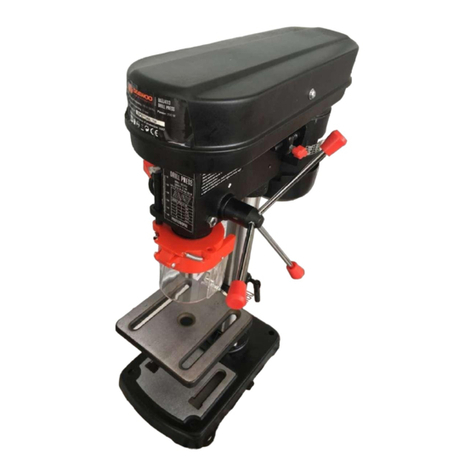
Daewoo
Daewoo DAZJ Series User manual
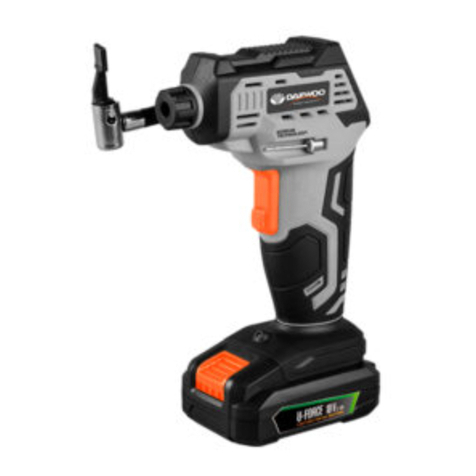
Daewoo
Daewoo DALI18-1 User manual

Daewoo
Daewoo DAES 500 User manual
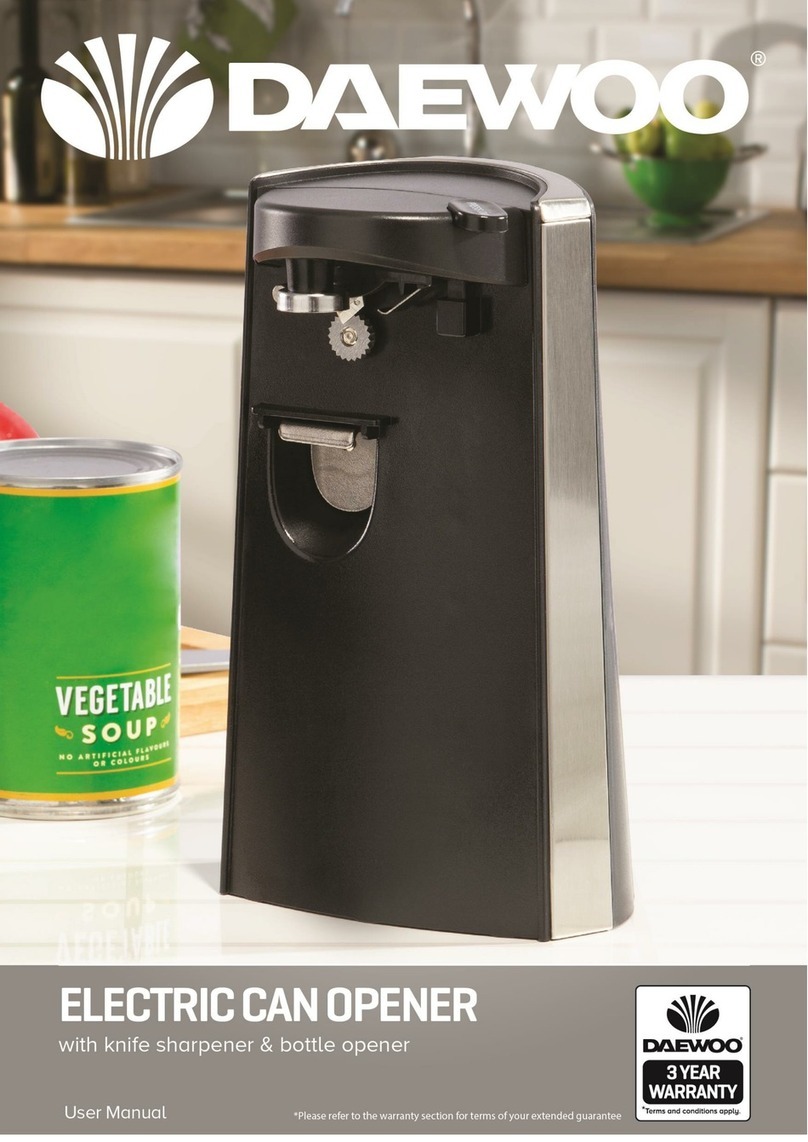
Daewoo
Daewoo SDA2313GE User manual

Daewoo
Daewoo DAHG2000 User manual
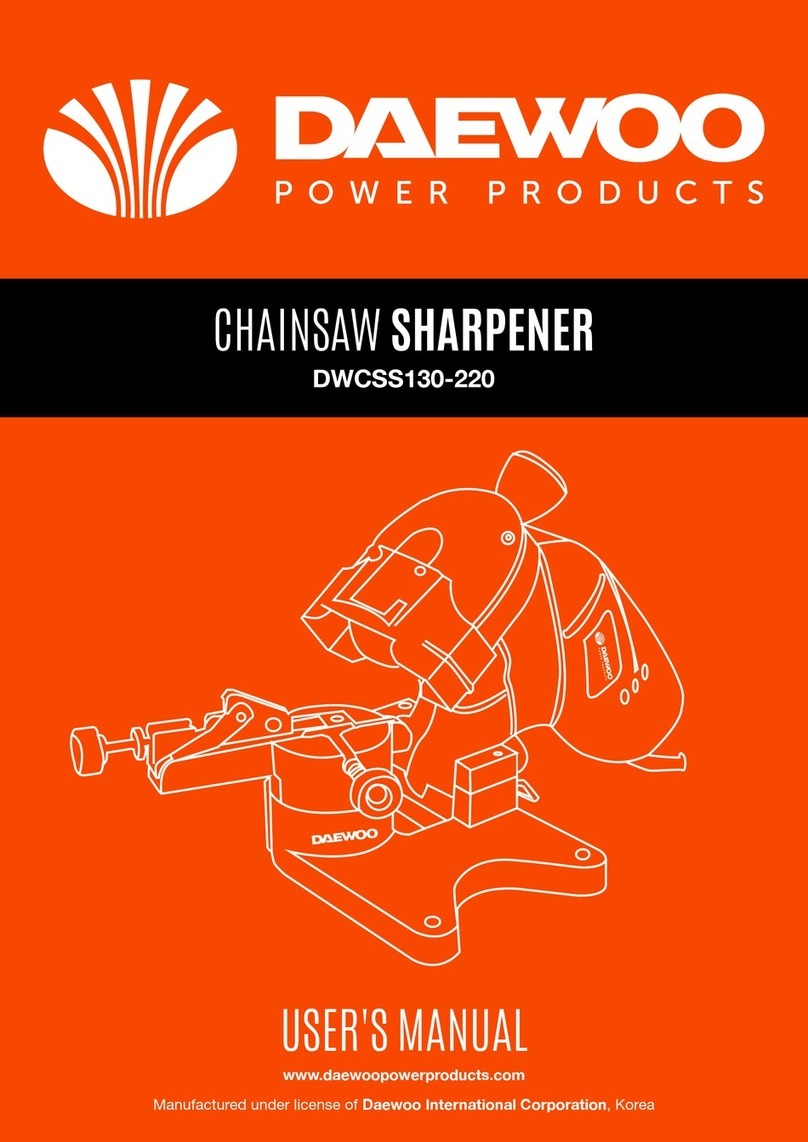
Daewoo
Daewoo DWCSS130-220 User manual
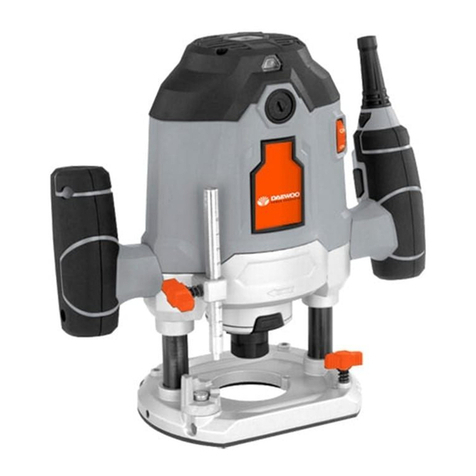
Daewoo
Daewoo DAER1250 User manual
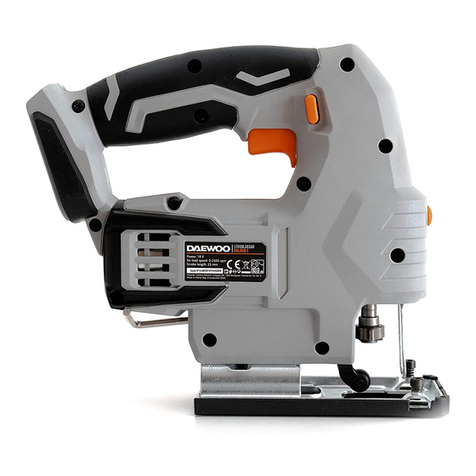
Daewoo
Daewoo DALJS18-1 User manual
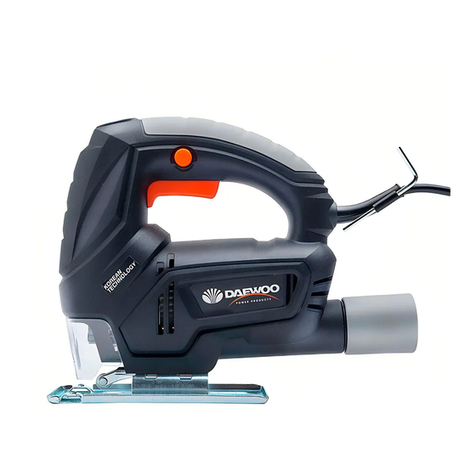
Daewoo
Daewoo DAJS 400 User manual

Daewoo
Daewoo DALJS18-1 User manual
Popular Power Tools manuals by other brands
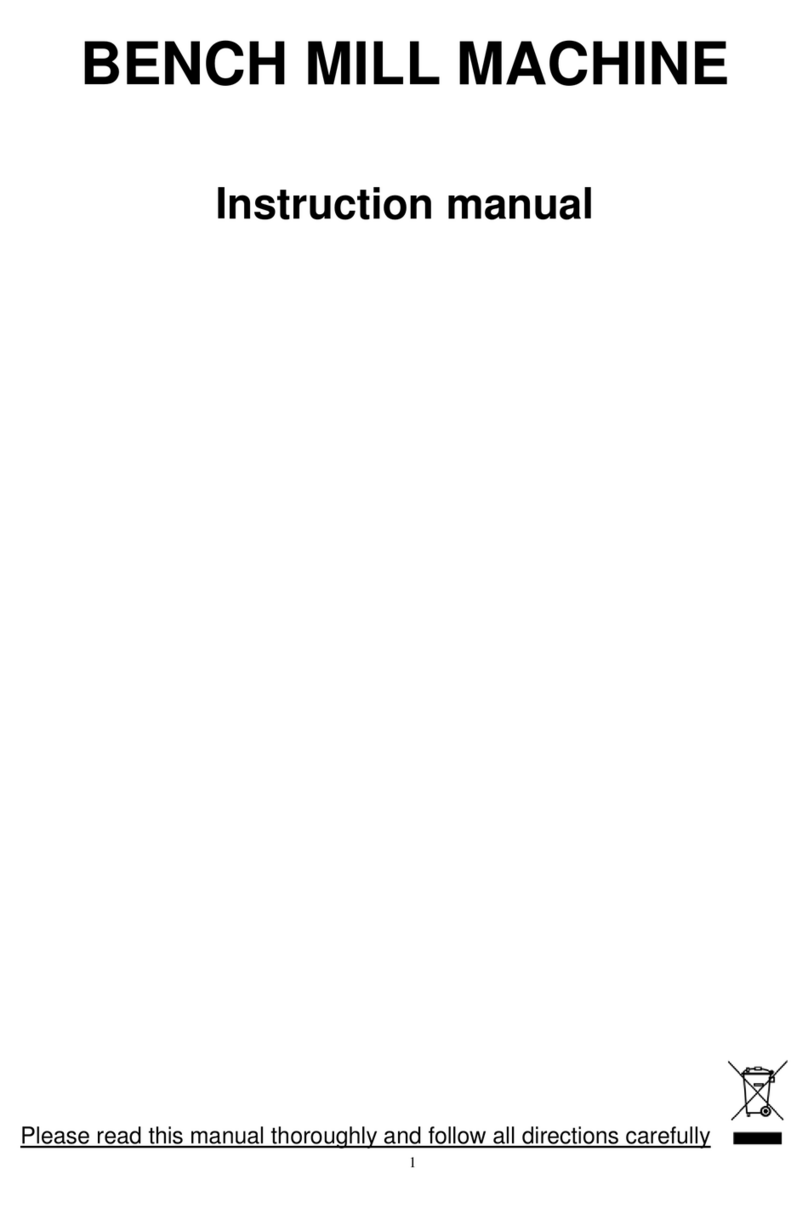
Proma
Proma FP-20A instruction manual
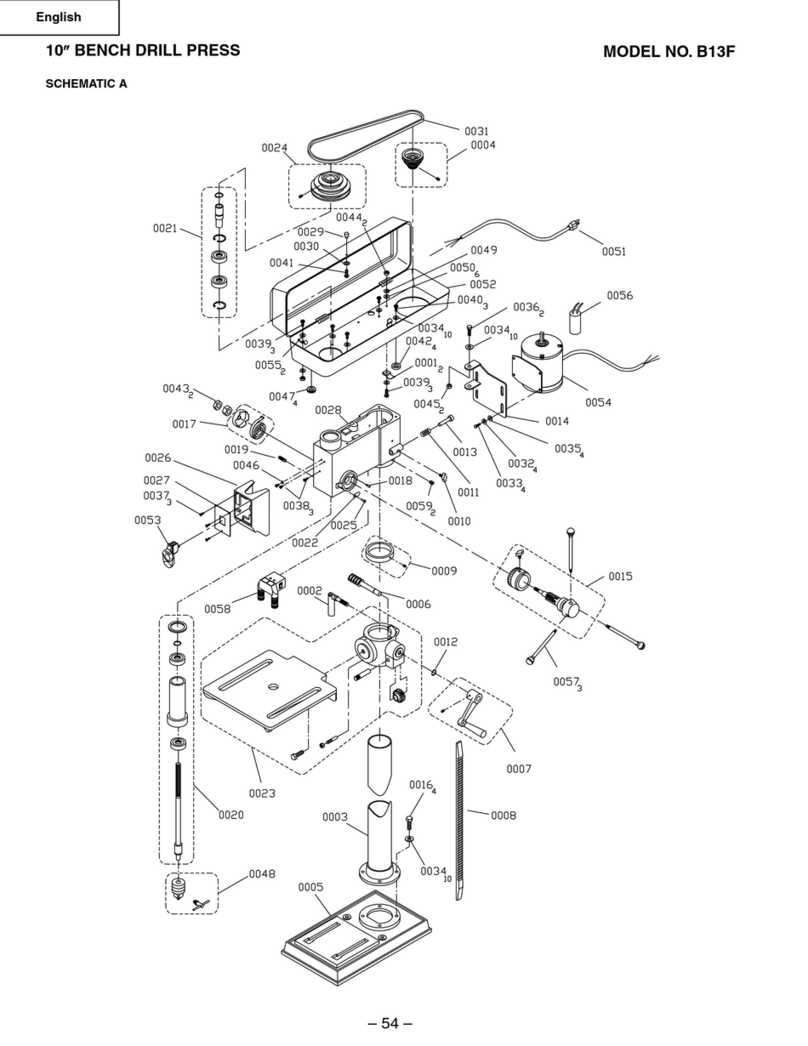
Hitachi
Hitachi B13F parts list
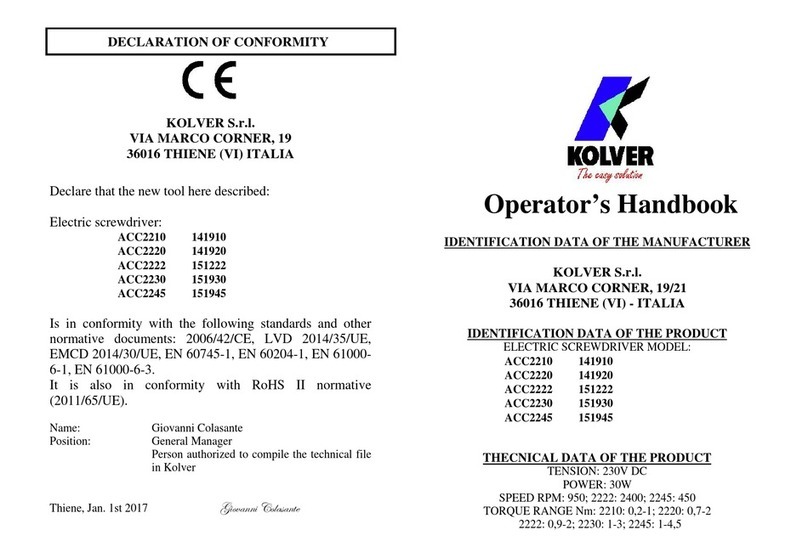
Kolver
Kolver ACC2210 Operator's handbook
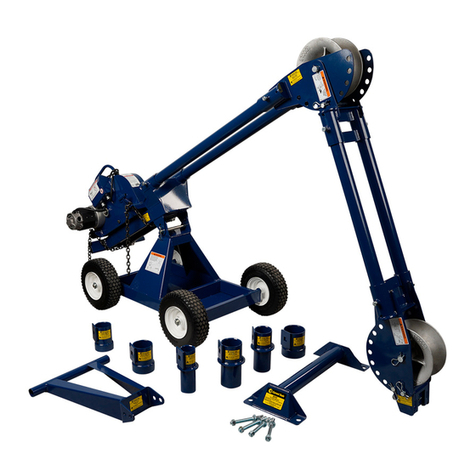
Current Tools
Current Tools Mantis 8885 Series Operating, Maintenance, Safety and Parts Manual
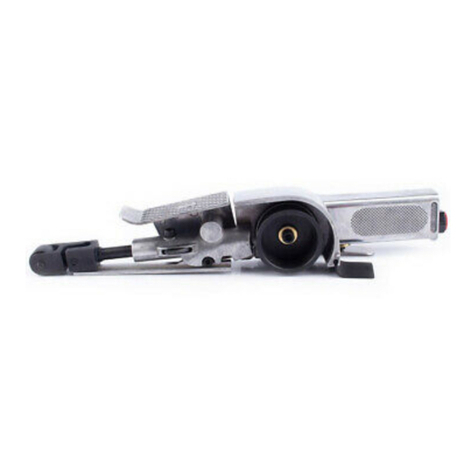
Sioux Tools
Sioux Tools Model 5566 User instruction
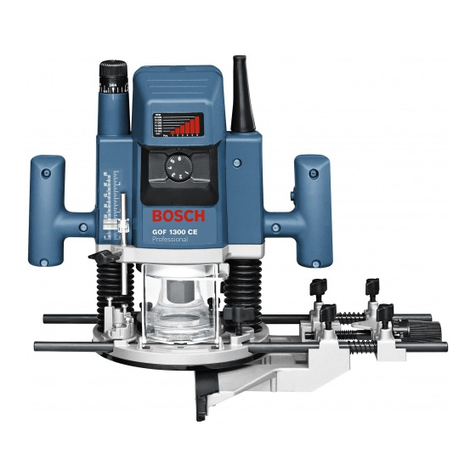
Bosch
Bosch GOF Professional 900 CE Original instructions
